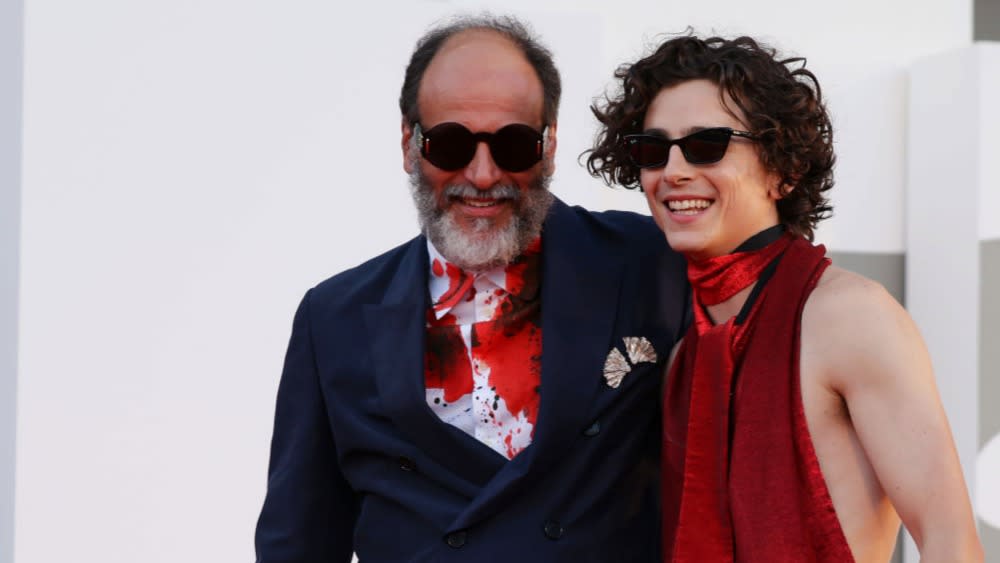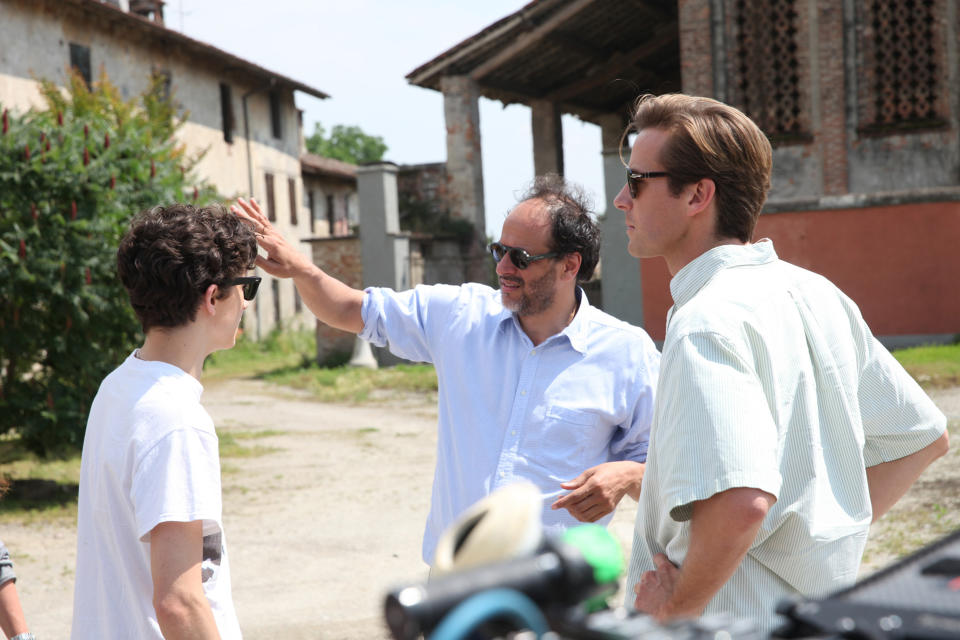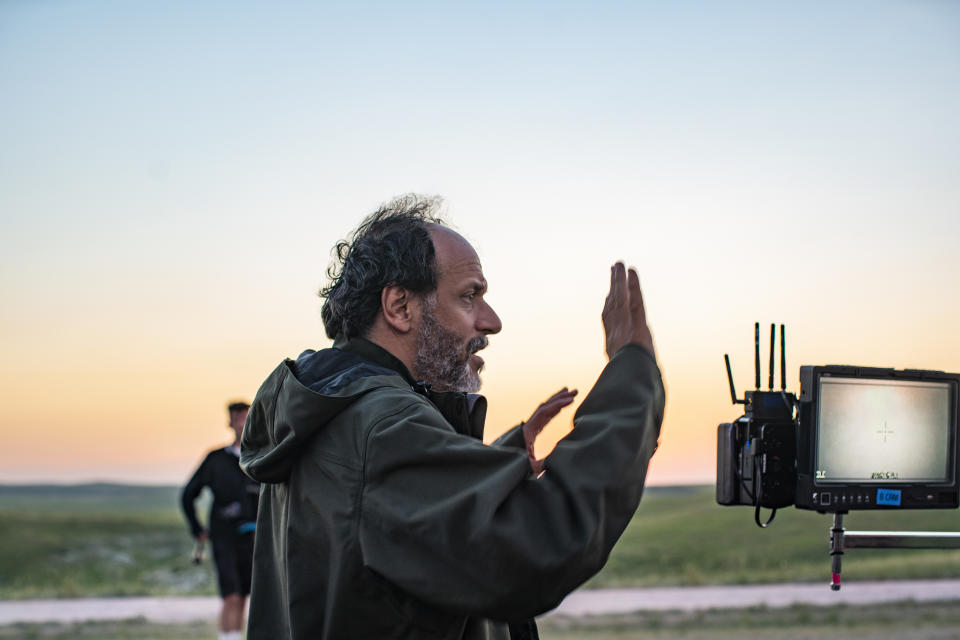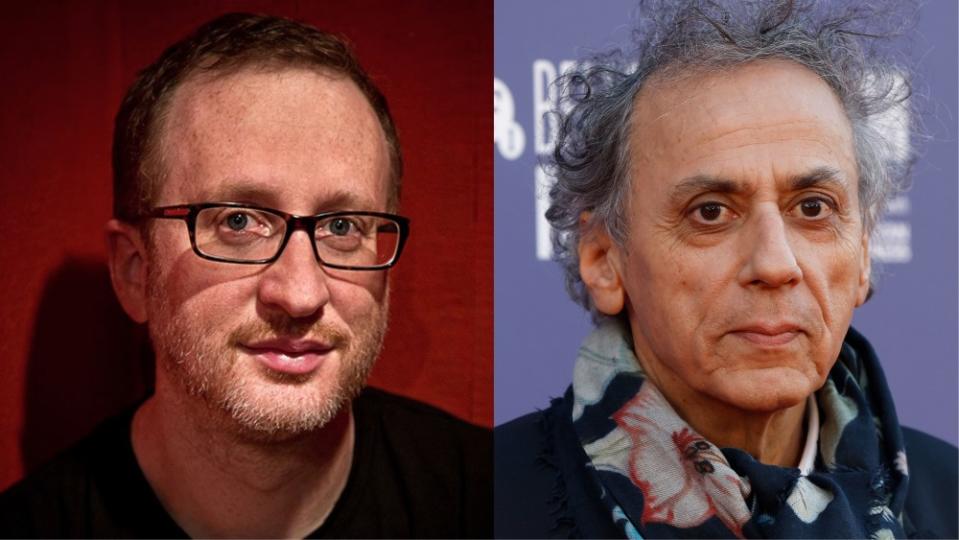Luca Guadagnino & Timothée Chalamet

On the set of “Call Me by Your Name,” director Luca Guadagnino gave his star Timothée Chalamet a suggestion. He wanted Chalamet to use his nose to convey the obsession his character, Elio, has with the older grad student, Oliver (Armie Hammer), who’s staying with Elio’s parents in Italy for the summer. “For Elio to try to smell what the scent of Oliver was in his clothing was a way to possess him, to own him, to really imprint Oliver on himself, the way in which you do when you are obsessed with someone and you really want to seduce that person,” Guadagnino said during a recent interview with IndieWire.
The decision of how to play this moment of solitude and abandon was left to Chalamet. “We did [the scene] four different ways that were all radically different and all on scales of physical expression — and everything felt gravy, I don’t know how else to put it,” Chalamet told IndieWire. “It was so cool as a young actor to work with directors confident enough to leave you with that impetus in front of the camera.”
More from IndieWire
In one of those takes, Chalamet grabbed a pair of red swim trunks hung on a headboard, and lay pondering them for a moment — then stuck his face inside the trunks, eventually kneeling on all fours, his body contorting like a cat’s as Elio inhales the aroma of his would-be lover. His unorthodox choice made the final cut. “The complete, incredible boldness of Timothée created one of the most honest and truthful erotic scenes I have ever filmed,” Guadagnino said. “I am thanking him forever for that because I truly love that moment in the movie very, very much.”

“Call Me by Your Name” was a watershed for director and actor, who each came out of the project with an Academy Award nomination and a new collaborator. It marked a culmination for Guadagnino, completing the self-described “Desire trilogy” whose previous installments had secured him international recognition and a major creative partner in Tilda Swinton. For Chalamet, the film was the first step toward becoming one of the biggest actors of his generation, an early, intimate glimpse at a star power that today drives both a major science-fiction franchise and Beatlemania-esque expressions of fan frenzy. Five years later, they’ve reunited for the cannibal love story “Bones and All,” on which Chalamet also serves as a producer. He said that Guadagnino has moved from “mentor” to “brother” in that time, though the director takes a different view of that starting point. “I’m happy that he felt I was a mentor,” Guadagnino said. “But I kind of felt that he was my mentor as well.”
Even before they decided to reteam, Guadagnino and Chalamet’s careers were inexorably linked. They met at the recommendation of Brian Swardstrom, the actor’s agent and a friend of the director; at the time, Chalemet was still a teen, and Guadagnino was attached to “Call Me by Your Name” only as a producer. He was used to doing general meetings with young actors, but Chalamet defied all expectations. “I didn’t meet an actor,” Guadagnino said. “I didn’t meet someone self-conscious. I didn’t meet someone who wants to make an impression. I met a very smart kid who was so curious about everything.” When Guadagnino took over directing duties from “Call Me by Your Name” screenwriter James Ivory, he knew he still wanted Chalamet to play Elio, even if he was rethinking some of the other casting choices. “For me it was a no-brainer to work with Timothée on this,” he said.
Though it’s hard to imagine now, Chalamet was accustomed to frequent rejection on the audition circuit when he signed onto the film version of André Aciman’s coming-of-age romance. The offer to play Elio was a vote of confidence he hadn’t yet received in his fledgling career, which had included a recurring role on “Homeland” and a part in Christopher Nolan’s “Interstellar.” “I felt a trust and a space within the tone of what [Guadagnino] was doing that was unlike anything I had worked on,” Chalamet said. He was allowed to try things — like putting a bathing suit on his head — and Guadagnino was responsive. No question was stupid.

Throughout “Call Me by Your Name,” it seems as if Guadagnino’s camera is capturing Elio’s most private moments — and, in turn, Chalamet’s. There are the scenes where Elio and Oliver brusquely flirt, but the most impactful moments are those of Elio alone. While this might immediately call to mind the scandalous peach sequence — a method of masturbation Guadagnino nearly cut from the film out of concerns for realism, before he and Chalamet independently confirmed its effectiveness — a more striking example is found in a tiny beat where Elio shaves his nonexistent mustache. Chalamet goes through the motions of brushing the razor over his upper lip and then looks at himself in the mirror almost as if he’s searching for his still nascent sense of self. Just before Guadagnino cuts away, his eyebrows furrow. We get the shuddering notion Elio doesn’t quite like what he sees yet.
The gangly movements of Chalamet’s body give Elio the exuberance that Guadagnino pointed to in our interview, but the director returns again to Chalamet’s face at the end of “Call Me By Your Name” in an unbroken shot of Elio crying in front of a fireplace. It’s a staggering coda, and also an example of the fundamental understanding between actor and director into which they’ve invited the audience.
Guadagnino said he told Chalamet about his impending success during the filming of “Call Me by Your Name” — success that thrust him into a Best Actor field that included such established heavyweights as Denzel Washington, Daniel Day-Lewis and Gary Oldman, before leading to a headlining role in Denis Villeneuve’s two-part “Dune” adaptation and the surreal scene at the Milan premiere of “Bones and All,” where swarms of dedicated Chalamet fans caused the red carpet to be shut down due to safety concerns. None of this has quelled Chalamet’s “beautiful, enthusiastic capacity of experimentation,” according to Guadagnino.

When screenwriter David Kajganich sent Guadagnino a script based on the Camille DeAngelis novel “Bones and All,” the director was immediately intrigued. By the time he reached the point where a drifter named Lee showed up, he knew he had to enlist his former star.
“The second I saw this character on the page, I felt very instinctively that that was a character that had to be played by Timothée,” he said. Lee — who meets and strikes up a kinship with fellow cannibal Maren (Taylor Russell) — was initially written as more self-assured, with what Chalamet described as “an alpha maleness.” The actor had a different idea for how to play this lost soul.
“I thought if Lee was equally fragile [as Maren], but that he was putting out an expression of security and independence and austerity, that there’s some more fun to play with there,” he said. “And then a journey to go on in which someone you’re in love with breaks you down.”
With these ideas in mind, Chalamet, Guadagnino, and Kajganich reshaped the screenplay. “That’s where I feel I earned my producer credit on this,” Chalamet said, before acknowledging the humility behind the statement, wanting to make it clear that he didn’t seek the title just for the sake of having it. “I hope all my input was warranted,” he added. “You never want to get to a place where people take your input because they have to and actually all your ideas are terrible.”
For evidence of how Chalamet’s ideas manifested, look to the point in “Bones” shortly after Lee and Maren meet, when they venture to the home of a man Lee has just eaten. Maren is tentative, but Lee, energized, is thrilled to find that the guy has a copy of Kiss’ “Lick It Up” on vinyl — he puts the record on the turntable, and a kinetic dance to the title song ensues. The music cue was intended as a small reference, but Chalamet wanted to erupt, an idea inspired by Ralph Fiennes’ wild moves in an earlier Guadagnino film, “A Bigger Splash.” “I thought it was maybe a moment that Lee could almost challenge Maren with his off-putting behavior, or with his passion,” Chalamet said. Guadagnino found it “beautiful,” an example of the “electric” way Chalamet uses his body. For a behind-the-scenes look at this sequence, and more from Chalamet and Guadagnino about their inaugural collaboration, watch the video below.
Guadagnino’s and Chalamet’s offscreen connection spills over onto set when they share a laugh or plan a “great meal” between takes, but when the camera rolls, Chalamet gives himself over to the reality they’re creating together. This yields scenes like the one near the end of “Bones and All” where Lee confesses a nightmarish secret about his past to Maren on a hillside in Nebraska. It’s a revelation that could be played for the sheer horror of it, but Chalamet wanted it to be a “self-realized actualization of something really dark and fucked” where Lee also searches for acceptance in Maren’s eyes. “I remember Timothée was really focusing to be very in that space throughout the three or four days of shooting,” Guadagnino said. “He was so deeply concentrated to get that out and to preserve the sense of exhilaration in the confession at the same time as the pain.”
The conversation is the defining sequence of “Bones and All,” largely thanks to Chalamet’s instincts. His vulnerability in describing a brutal event produces a sensation that’s heartbreakingly romantic, even in the context of Lee and Maren’s taste for human flesh.
The collaboration on “Bones and All” didn’t stop when shooting did. Guadagnino called on Chalamet in his capacity as a producer even when they were working on the marketing for the film. It was Chalamet who proposed Leonard Cohen’s “You Want It Darker” as the music for the first trailer. “He knew that was going to talk very precisely to what they call Generation Z,” Guadagnino said. It signaled something to Guadagnino that he already knew: Chalamet is a natural filmmaker himself. “I wouldn’t be surprised if one day Timothée becomes a director,” he said. “I can see how he’s very keen in visual language. He’s not really focused just on the character he’s playing, but the movie he’s in.”
Guadagnino has been pitching the possibility of a “Call Me By Your Name” follow-up for years now — he sees it more as an installment in the “chronicles” of Elio rather than a sequel. But don’t surprised if his next project with Chalamet goes in a different direction. “I’m interested to see what he wants to do,” Guadagnino said. “I cannot dictate to him what I want him to do. That would be banal. What I know is that I want to make more characters with him that are as profound and as surprising as the ones we made already.”—Esther Zuckerman
VIEW MORE INFLUENCERS PROFILES

Luca Guadagnino & Timothée Chalamet
With “Bones and All,” the director and star of “Call Me by Your Name” continue to give each other the space to be bolder, darker, and more vulnerable.
December 1, 2022 12:08 pm

Nicholas Britell & Cellist Caitlin Sullivan
“She Said” and “Succession” composer Britell says he knows he’s on the right track when Sullivan pokes her head into the couple’s home studio.
By Erik Adams
November 18, 2022 2:17 pm

James Gray & Cinematographer Darius Khondji
What’s the collaborative process behind “The Immigrant,” “Armageddon Time,” and “The Lost City of Z”? “No conversation. Just sharing paintings.”
November 10, 2022 11:00 am
Best of IndieWire
The Best Thrillers Streaming on Netflix in October, from 'Fair Play' to 'Emily the Criminal'
Christopher Nolan's Best Shots: 40 Images That Define the Director's Career
Sign up for Indiewire's Newsletter. For the latest news, follow us on Facebook, Twitter, and Instagram.


